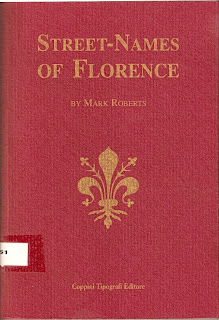
I was curious about Florence street names so I checked this smallish book out of the British Library, Street-Names of Florence, by Mark Roberts. If you are so inclined, it provides endless hours of diversion as you read about a street name and then wander off (literally and figuratively) on tangents looking for this or that. Some interesting tidbits from the book:
- Via dei Leoni (near Piazza Signoria). Lions are one symbol of Florentine jurisdiction and there were indeed live lions kept in Florence in the 13th and 14th centuries. They were kept on or near this street.
- Via del Canneto (Oltrarno). “Canna” is a reed and “canneto” is a read break (or grove of reeds). We live on this street.
- Costa Scarpuccia (Oltrarno). Probably a diminutive of “scarpata” meaning slope. The street is very steep. The suffix “uccia” expresses smallness (a short street in this case - likely) or endearment (maybe people love to climb this street? – unlikely). This street is near where we live.
- Vicolo della Cava. This small street used to lead to a “cava” or quarry for the honey-colored building stone called “pietra forte” or strong stone, on the Boboli hillside. Access to the quarry was closed in the mid 16th century after Cosimo I and Eleonora bought the Pitti Palace and the Boboli gardens were being laid out. (She bought the Pitti because she had the money.)
- Via delle Oche. The street of the geese. “Oca” is goose and “oche” is geese. The origin of the street name is uncertain. Two possibilities could be that it refers to geese ate on All Saints day or a family's coat of arms who lived there.
- Via dell'Olmo. Street of the elm; a big elm tree stood on this street.
- Via Madonna della Tosse. Mothers came to a location on this street to pray for their children who had whooping cough – hence then name "Madonna of the Cough". Eventually the church of the whooping cough came to be: La Chiesa della Madonna della Tosse. Finally, the book mentions that “borgo” means that the street was at one time outside the city walls. I had wondered why that was used in street names. Good, but which walls? There seem to be several old city walls.
I was wondering of you knew where to get a copy of this book- Ive tried looking it up online but cant find anything. thanks
ReplyDeleteI checked it out of the British Institute in Florence (www.britishinstitute.it). It was written by a librarian there. Sorry, I don't know where you could get it. You might try 1) emailing the institute and asking the author or 2) contacting the publisher (I think it's Coppini Tipografi Editore) or 3) going to Florence and checking it out yourself! I wish I were there and I could walk over to the library and ask for you, but now I am back in the USA. Good luck.
ReplyDeleteIt is available in most Florence bookstores. I bought mine at Librerie Feltrinelli on via de' Cerretani.
ReplyDelete